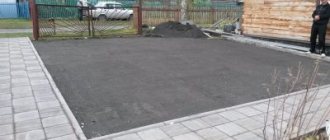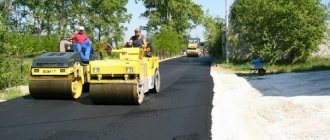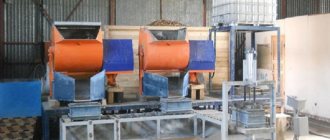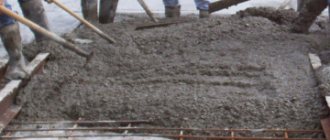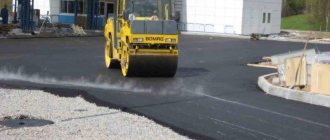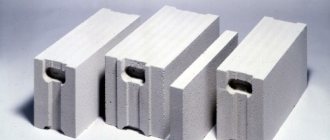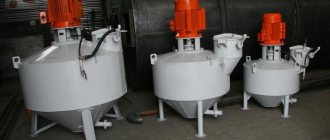Home / Articles / Construction of an asphalt concrete plant
Alyona
A specialist will accept your application and answer your questions!
+7
An asphalt concrete plant (ACP) is a complex of technological equipment and structures that are located in one place and are oriented for the production of asphalt mixture used for the construction, repair or restoration of asphalt pavement. For full-fledged operation of the asphalt plant, it is necessary to have fully operational equipment, qualified service personnel and raw materials (bitumen, crushed stone, sand, etc.). To understand the technological production cycle and how an asphalt concrete plant works, you should clearly know the purpose of its main components:
- technological preparation of bitumen with dosed supply to the asphalt mixing plant;
- technological preparation of crushed stone mass, quartz sand, active substances and their supply to the asphalt mixing plant;
- thorough mixing of various components in order to obtain a finished asphalt mixture;
- full cycle of asphalt concrete mixture production.
Design features
The design of an asphalt concrete plant depends on the functionality and performance of the equipment. In general, full-fledged operation of the asphalt plant is possible with a wide range of equipment, machinery and devices:
- Asphalt mixing plant.
- Receivers of solid consumables for their supply to the asphalt mixing plant.
- Receivers of bitumen, with its heating and supply to the mixing plant.
- Receivers of active substances for the purpose of heating them and feeding them into the mixing hopper.
- Equipment for operations with ready-mixed asphalt.
To increase the productivity and reliability of asphalt plant equipment, it may include additional elements:
- boiler rooms;
- bitumen warehouse;
- administrative and domestic buildings;
- quality laboratory;
- compressor station;
- backup power supply facilities;
- fuel and lubricants warehouse;
- repair shop, etc.
In each individual case, the asphalt plant device may differ depending on the assigned tasks, the equipment manufacturer and the adopted production technology.
Description of manufacturing technology in production
In production conditions, heated bunkers are required where the solution will be stored. The components are first mixed at high temperature. The location is selected close to construction work. This is due to the fact that the cooled coating is poorly compacted, which affects the quality of the final result.
Why do seas and oceans become dirty?
At the initial stage, all components of the solution are dried, since they are supplied in a wet state, and then sifted. The presence of moisture is unacceptable. This leads to a decrease in the strength of asphalt. Drying is carried out at a temperature of 160 degrees.
The incoming mineral filler is crushed to obtain a fine fraction. If drying at the first stage does not give satisfactory results, then it is repeated after sifting the components.
Next, the formation of the asphalt mixture goes through the following stages:
- Sand and crushed stone are placed on a conveyor that moves towards the bunker. Here they are mixed.
- Directly on the conveyor, bitumen is added to the crushed stone-sand mixture. Mixing to the required consistency occurs at a temperature of 170 degrees.
- All necessary additives are added to the solution and mixed at this stage.
The resulting asphalt goes into a bunker. He can stay here for up to 4 days. During this time, the solution must arrive at the site and be processed.
Operating principle of asphalt plant
All asphalt concrete plants operate according to two main technological schemes:
- Continuous production cycle.
- Cyclic work.
These two technologies have fundamental differences; mixing of all components is carried out in completely different modes. In the first case, all components are mixed in one constant flow, and in the second, in portions.
The main advantages of asphalt plants with cyclic operation:
- The ability to quickly change the parameters of the produced asphalt at the stage of loading raw materials.
- High quality of the mixture, which is achieved by well-established technological processes.
The main disadvantages of asphalt plants for cyclic operation are low mobility and high acquisition costs.
A continuous production cycle asphalt concrete plant has the following advantages:
- high speed of installation of technological equipment;
- short deadlines from the moment of purchase to receipt of the first asphalt;
- the cost is lower than similar equipment for cyclic operation.
Among the main disadvantages of a continuous cycle asphalt plant is a high degree of dependence on feedstock, which has a significant impact on the finished mixture.
To understand how an asphalt plant works, it will be enough to look at its equipment - the presence of a mixing tower is the main feature of an asphalt plant with cyclic operation.
Asphalt plants and manufacturers of asphalt concrete mixtures
The production of asphalt concrete mixtures, as an independent segment of industrial production, has developed relatively recently. With the development of the oil refining industry, it became possible to replace natural bitumen (resin of Judas) with products of petroleum distillation (cracking). Asphalt production, despite its apparent simplicity, is a rather complex technological process that requires high-quality technical solutions and strict adherence to technological regimes.
The production of the mixture is based on the process of enveloping natural stone of a certain fraction (crushed stone) with bitumen. By adding a mineral additive (concrete), an asphalt concrete mixture is created, from which another type of coating is obtained. Concrete is added in the form of a solution or in the form of crushed waste from concrete production. The importance of compliance with technical production conditions is evidenced by the bringing of GOST 9128-2009 in accordance with European standards and its mandatory application by seven CIS countries.
The main feature of the gradation of asphalt concrete plants is productivity (volume/weight of the mixture per unit time), which affects the layout and placement of the plant. The following types of plants are distinguished.
Stationary plants
The productivity of such plants is tens/hundreds of tons per hour. They use multi-hopper mixture preparation systems with automated dosing (transportation) systems for raw and finished materials. A high level of process automation makes it possible to take into account daily, weather and seasonal fluctuations in the needs of road workers for the working mixture. Choosing a location for such a plant is a serious technical and economic task that requires taking into account many factors: from the cost and availability of raw materials (energy, etc.) to solving logistics (transport) problems.
Mobile plants
Designed to ensure the construction of long-distance road facilities at a sufficient distance from large industrial hubs. This is a smaller copy of a stationary modular plant, the design of which provides for the possibility of dismantling and moving to a prepared site. The degree of mechanization and automation of technological processes is at the stationary level, as are the requirements for product quality. Mobile plants are the most flexible and efficient production model, capable of solving most road construction problems.
Mobile factories
This is a variant of a mobile plant. The difference lies in the fact that the plant modules are equipped with their own wheels, which allow the plant to be transported by tractors without the use of additional equipment (platforms). Used to solve problems of local significance.
Asphalt concrete plants of any model are very promising objects for investment, but they require serious study in terms of assessing the prospects for the development of the road network in each specific case in relation to the region.
Scheme of an asphalt concrete plant
The asphalt plant layout diagram for classic continuous installations is as follows:
- Hopper dispensers.
- Assembly line.
- Conveyor belt with moisture level check.
- Mixing drum.
- Recycled asphalt dispenser.
- Intensive mixing area.
- Bunker.
- Ventilation unit.
- Collection bin.
- Operator panel.
- Silo for storing mineral materials.
- Bunker for recycled materials.
- Conveyor belt with moisture level check.
- Filter silo.
- Container for bitumen.
- Fuel and lubricant heater.
- Assembly line.
The traditional layout of a cyclic asphalt concrete plant is as follows:
- Hopper dispensers.
- Assembly line.
- Assembly line.
- Drying centrifuge.
- Elevator tower.
- Mixing container.
- Collection bin.
- Elevator for mineral materials.
- Silo for mineral materials.
- Filter silo.
- Ventilation unit.
- Bitumen storage area.
- Oil heater.
- Operator console.
The asphalt plant design may vary depending on the availability of additional technological equipment.
Asphalt production in Moscow
Active production of asphalt in Moscow and the Moscow region causes a high level of competition. More than 50 enterprises daily produce thousands of cubic meters of mixtures of different types, but all plants can be divided into two groups.
Cyclic production with batch dosing makes it possible to quickly change recipes and separate inert materials into fractions, which ensures the accuracy of the particle size distribution. They are in demand in the metropolis, where batches of mixtures of different types and volumes are regularly required.
Continuous asphalt production plants without pre-conditioning of aggregates provide a constant flow of mixture that can be stored in silos for up to several days. To maintain quality - maintaining the programmed recipe and grain composition - a separate crushing and screening complex is installed at the production site.
Features of the cold product
The production of such a solution is possible only in factory conditions. Installation is carried out independently. Distinctive features are the following changes in technology:
- The heating process of the coating occurs in the temperature range of approximately 70−110 degrees.
- At the mixing stage, polymer additives are added to the solution. Their necessity is to form an antioxidant film on the surface of the bitumen, which performs a protective function.
The concept of “cold asphalt” is relative. In frosty weather, the solution is heated before installation. This is necessary in order to bring it into a plastic state. At the same time, the installation area is heated using burners. It is possible to carry out such work at low temperatures - down to -20 degrees.
How the Moon appeared: myths and assumptions
The positive aspects of cold asphalt include the absence of the need for its rapid production. However, there is a significant drawback - its strength is 2 times lower than that of a hot product.
During the compaction process, a wooden beam or vibrating plate is used. The surface is brought to its final state after the start of vehicular traffic.
The maximum pressure that such a coating can withstand is 3.5 tons. Therefore, it is not recommended to cover large areas with it.
Home production
Knowing how asphalt is made in a factory, you can make it at home. The process consists of the following steps:
Mind reading device created in Japan
- A concrete mixer is required. Crushed stone and sand are poured into it in a 2:1 ratio. It is important that the materials are dry.
- Take a bucket with a capacity of 15 liters separately. Bitumen is placed in it and heated. To make mixing easier, add a little shampoo. During the heating process it burns out. Then plasticizers and polymers are added.
- The contents of the bucket are being mixed with a mixture of crushed stone and sand. It is important that the contents of the concrete mixer are also heated. To do this, add 50 liters of water, which is brought to a boil. Mixing with bitumen continues until the liquid evaporates.
Considering that bitumen should be heated to a temperature of 100 degrees, and water boils under the same conditions, it turns out that these values coincide.
After this, a compressor is used to clean the asphalt laying area and pour out the solution. Leveling is carried out with a roller.
Asphalt is a material suitable for covering highways. Its price is significantly lower than a concrete base. In addition, there is the possibility of reuse when using special technologies.

